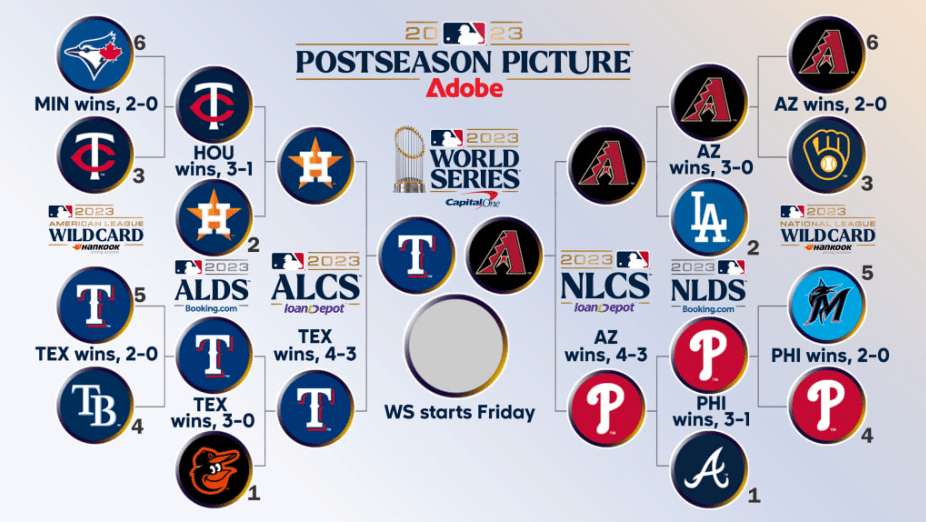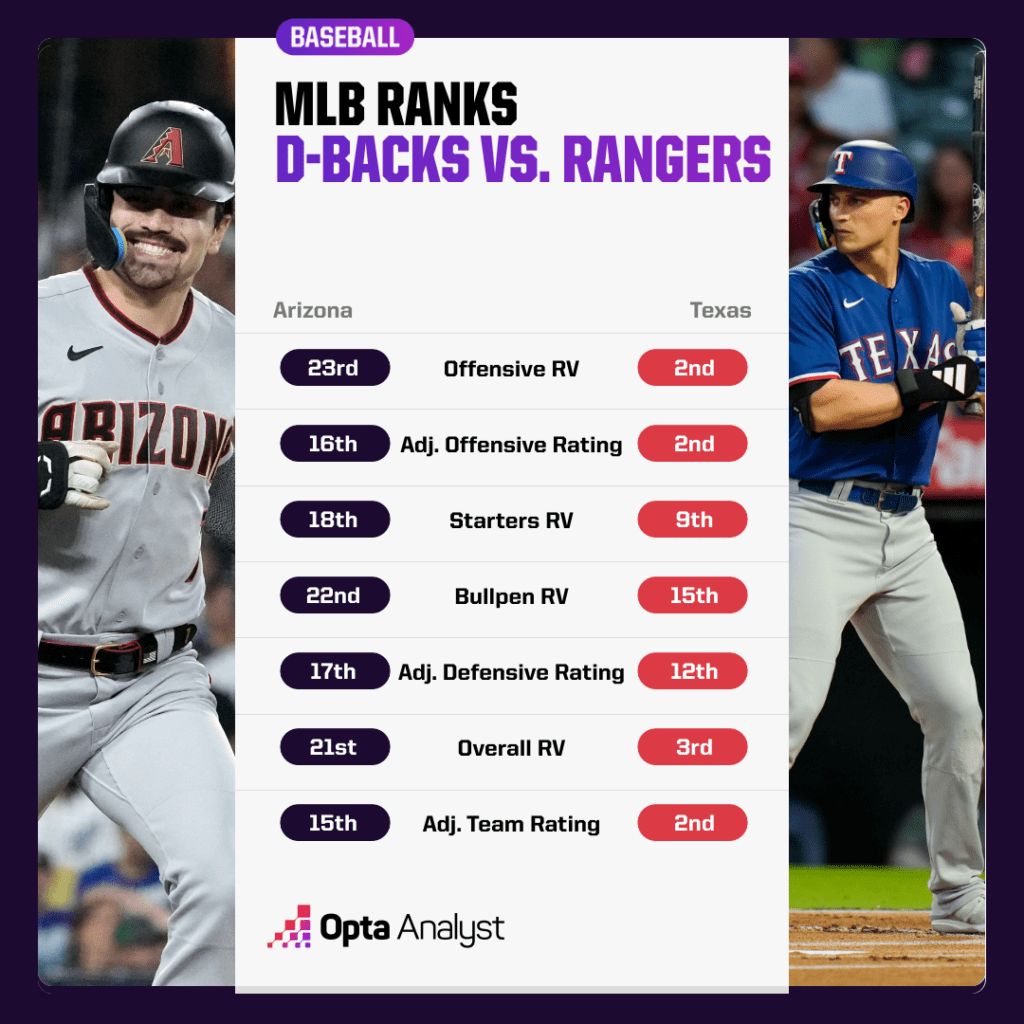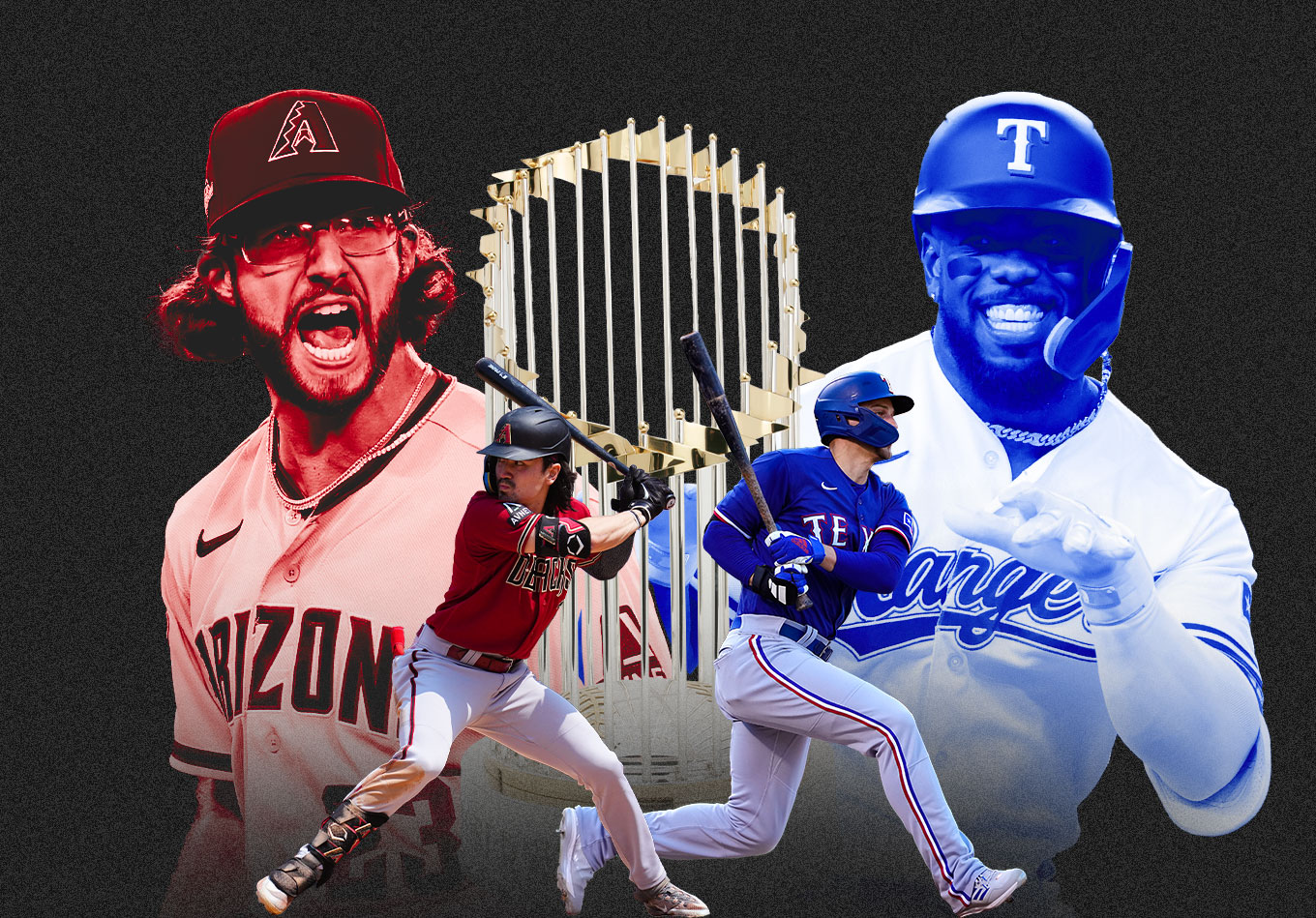It certainly isn’t what anyone expected.
A total of 14 games were necessary to determine that the sixth-seeded Arizona Diamondbacks and the fifth-seeded Texas Rangers will be playing for the Major League Baseball title.
Both pennant winners have been underdogs in most of their respective series, but they’ve managed to use their weapons and resources efficiently to secure their ticket to the last matchup of the MLB postseason.
Who has the advantage? It depends on which facet of the game we are talking about. To find the answers, we’re using a series of metrics and advanced stats, plus the evidence we have at hand: our adjusted team ratings, raw value data, and other numbers you will find useful.
Let’s start by clarifying some concepts. Adjusted team ratings (which includes adjusted offensive and defensive ratings) are basically how many runs per nine innings above or below average teams are relative to the league average. This helps us normalize performance from league environmental factors that can either inflate or deflate its numbers.

Our adjusted team ratings are more descriptive than predictive, but they’re a really useful tool to understand some situations with the added bonus that they mesh regular-season and playoff performance.
On the other hand, raw value analyzes performance on a per-pitch basis and not by just looking at the outcome of an at-bat. We have total raw value, a cumulative stat; and RV +/-, a rate stat in which 100 is the league average value. For pitchers, anything lower than 100 indicates above-average play; and the opposite is true for hitters.
Having cleared that up, let’s see who has the edge in each aspect of the Fall Classic, which opens with Game 1 on Friday in Arlington.
Offense
When it comes to offense, the Rangers were one of the best teams in baseball this season and hold the advantage in the World Series, without a doubt. It’s a deep group of talented, productive hitters that include Corey Seager, Marcus Semien, Adolis Garcia, Mitch Garver, Jonah Heim, Leody Taveras, Nathaniel Lowe, and rookies Evan Carter and Josh Jung.
With a 113.7 RV+ (remember, 100 is league average for hitters), the Rangers are currently ranked second in MLB behind the Atlanta Braves. They also rank second in adjusted offensive rating behind the National League East champs.
If Shohei Ohtani wasn’t so good and unique, you could make a very convincing case that Seager deserves to be the AL MVP. He has the best RV+ among qualified hitters at 182 and hit an incredible .327/.390/.623 with 75 extra-base hits (42 doubles, 33 homers) and a 1.013 OPS in the regular season. A Rangers hitter hasn’t been this good and productive since 2010 Josh Hamilton.
Seager has also been a beast in postseason play against the Tampa Bay Rays, Baltimore Orioles and Houston Astros with five doubles, three round-trippers and a 1.127 OPS. He also has 12 walks (!) and just seven strikeouts.
If we are talking about impact players on the Texas offense, however, we have to mention reigning American League Championship Series MVP Adolis Garcia. Life has taken him through so many roads that it’s hard to keep track at this point: from playing in Japan to defecting from his native Cuba for good, Garcia had to establish residence abroad to have a chance at signing with an MLB team.
He did it in February 2017 with the St. Louis Cardinals, but they designated him for assignment in late 2019 and was subsequently traded to the Rangers. Texas also DFA’d him in early 2020, but no one claimed him and he was outrighted to the minors with an invitation to spring training.
He paved his own way from there: 2020 didn’t bring many chances, but 2021 represented his breakthrough with 31 homers and 90 RBIs. He became a household name and had the season of his life this year with 39 homers, a .836 OPS and a 138 RV+.
Garcia set an MLB record in the ALCS with 15 RBIs and also hit five homers and posted a 1.293 OPS. In 12 postseason games this year, he has 20 RBIs. With style and flair, Garcia has made plenty of detractors and critics, but he has been carrying the Rangers and that’s all that matters.
The rest of the names in the offense also come with top productions. Carter hasn’t stopped hitting since making his MLB debut and has a .987 OPS in the postseason after posting a 1.058 mark in 23 regular-season games. Jung had 25 doubles and 23 dingers before October, Semien scored 122 runs and hit 29 balls out of the park, and the Garver-Heim catching duo has been magnificent. Stopping this offense will represent a huge challenge for the D-backs.
With a 94.8 RV+, the Diamondbacks have the 23rd-best offense in baseball. The adjusted team ratings give them the 16th position in MLB when it comes to offensive production. As you can see, the collective numbers are nothing to write home about.
In October, the Snakes averaged 4.3 runs over 12 games: nothing extraordinary, but good enough to compete if things break right.
Corbin Carroll might have a mediocre 100 RV+ (basically league average) but he came through when it mattered most in Game 7 of the NLCS: a 3-for-4 performance with two steals, two runs and two RBIs to help set the table for Arizona’s offense.
You just can’t dismiss a guy who had a .868 OPS, 25 home runs, 54 stolen bases and 116 runs as a rookie. On the other hand, first baseman Christian Walker (121 RV+) has been a bit cold in the playoffs, but at least he has contributed 11 walks to this date.
Before striking out four times in Game 7 on Tuesday night, Ketel Marte had been Arizona’s hottest hitter in the playoffs with a .358/.382/.604 line, a .986 OPS, two dingers and two thefts. He also had a fine regular season (114 RV+, 94 R, 25 HR, 82 RBI, .844 OPS) and will be a staple in the lineup during the World Series.
Two of the most pleasant surprises have been Gabriel Moreno and Alek Thomas. The former is boasting a cool .852 OPS with three homers and nine RBIs in the postseason, while the latter has a .865 OPS and four big flies.
Arizona’s offense is good and competent. Compared to the Rangers, however, it lacks punch and depth.
Advantage: Rangers
Starting Pitching
The Rangers rank 12th in adjusted defensive rating, which combines a team’s pitching staff and defense, but their starting rotation sits ninth in RV- (99.6).
The Texas rotation has, in theory, two guarantees and a series of question marks. Raw value data, specifically RV-, will tell you that Jordan Montgomery has been pretty average to this point (99), but the former New York Yankees and St. Louis Cardinals left-hander posted a 2.79 ERA in 67.2 regular-season frames with the Rangers and is at 2.16 in 25 innings in the playoffs.
Former Boston Red Sox right-hander Nathan Eovaldi, who has a 90 RV-, has also been magnificent in October with a 2.42 ERA in 26 innings so far. After that, things get a bit murky.
If Max Scherzer (80 RV-), who was acquired from the New York Mets earlier this season, is able to recover his pre-injury form – he suffered a teres major strain in September and returned in the ALCS – he has a chance to enter the aforementioned duo and turn it in a trio. After two starts and a 9.45 ERA against last year’s World Series champion in the AL Division Series, however, things are not looking so good on that front.
Andrew Heaney is the other pitcher besides Monty, Eovaldi and Scherzer to start a game for the Rangers in the postseason. He has a 112 RV-, but posted a solid 4.15 ERA with 151 strikeouts in 147.1 frames in the regular season.
Jon Gray, Dane Dunning and Martin Perez are also capable of making starts but are more like bullpen options at this point.
Arizona’s pitching ranks 16th, and that includes defense, too. Despite having Zac Gallen (97 RV-, 17-9, 3.47 ERA and 220 K in the regular season) and Merrill Kelly (92 RV-, 3.29 ERA), the team’s rotation is 18th in our raw value rankings.
There is an important factor here, and it’s the emergence of rookie Brandon Pfaadt as a legitimate third option in the postseason rotation. The righty has a 2.70 ERA in 16.2 October innings, with a sparkling 22/3 SO/BB ratio. In a heroic Game 7 performance at Citizens Bank Park, he limited Bryce Harper and the high-powered Philadelphia Phillies to two runs in four innings while striking out seven.
Whereas Gallen has been a bit off in the playoffs with a 5.24 ERA in 22.1 innings, Kelly, like Pfaadt, has been brilliant with a 2.65 ERA and 19 strikeouts in 17 frames. As a group, Arizona starters have a solid 3.63 ERA in postseason play.
Basically, the D-backs only trust three starters, and unless they are willing to go to one of their trio of arms on short rest, they could be forced to go with a bullpen game in one of the World Series matchups (like they did against the Phillies in Game 4 of the NLCS).
Advantage: Even
Bullpen
The Rangers have had a middle-of-the-pack bullpen if we combine regular season with playoff play so far, at least according to raw value. They rank 15th with a 94.0 RV-. In October play, the relief corps has posted a 3.72 ERA with a 37/25 SO/BB – passable, but not great.
Closer Jose Leclerc had been lights out until running into Jose Altuve in Games 5 and 7. Now, he has a 4.35 ERA. It might be difficult to trust Aroldis Chapman, but has a 1.42 ERA in 6.1 innings in the 2023 postseason despite a 4/4 SO/BB.
Josh Sborz (1.04 ERA in 8.2 IP) and Cody Bradford (1.59 ERA in 5.2 IP) have also been great, but other than that, there aren’t many guarantees in this unit. If Texas has a potential weakness, it’s probably the bullpen.
Arizona’s relievers rank 22nd in raw value among the 30 MLB teams. However, the team has mastered the art of resource optimization in the 2023 postseason.
Much like it happens in the starting pitching department, the D-backs have a group of relievers they trust and are not afraid to send them out there for as much as they need.
Kevin Ginkel, Ryan Thompson and closer Paul Sewald, acquired from the Seattle Mariners earlier this season, have allowed just three earned runs with a 32/6 SO/BB ratio over a combined 27.2 innings in the 2023 playoffs. Evidently, all three will have to pitch a lot if Arizona is to stand a chance.
Other guys such as Joe Mantiply, Kyle Nelson, Miguel Castro and Luis Frias have contributed to Arizona’s improbable run. The pen has yielded an incredibly solid 2.76 bullpen ERA.
Advantage: Diamondbacks
Overall
Overall, the Rangers rank second in our adjusted team ratings and third in overall raw value, so it’s certainly not a coincidence or an accident that they are representing the American League in the World Series.
Bruce Bochy is certainly no stranger to this stage, leading the San Francisco Giants to three titles in 2010, 2012 and 2014.

Arizona is ranked 15th in adjusted team ratings and 21st by raw value. The stats somewhat validate the six-game gap between the two squads in the regular season. That doesn’t mean the Diamondbacks can’t compete, though. They are a young, hungry and well-coached team that will try to shock the world and win the trophy.
If we had to pick a favorite, we wouldn’t hesitate to give that moniker to the Rangers. Sure, they have home-field advantage, but that’s been more of a curse than a blessing in these playoffs.
And remember, the Milwaukee Brewers, Los Angeles Dodgers and Phillies were all favorites against Arizona, and they’ll all be watching this series on TV.
World Series Prediction: Rangers in Six
Be sure to check out all our coverage of the NBA 2023-24 season. And don’t forget to follow us on Twitter and Instagram.
